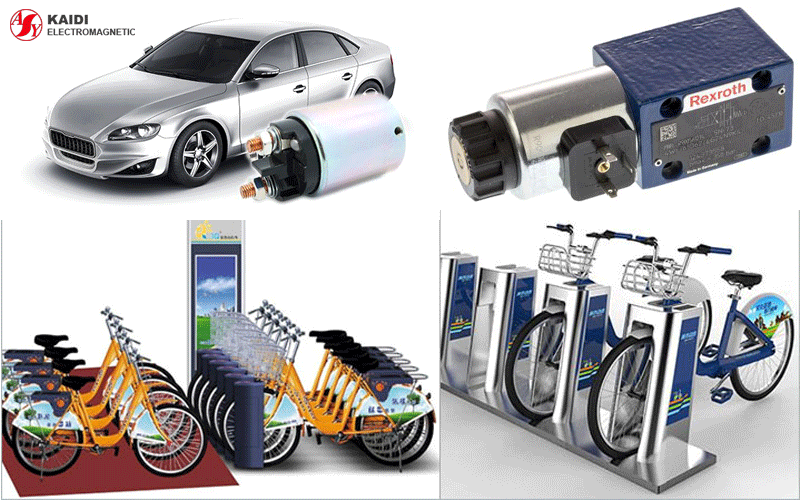The solenoid is the actuator that changes electric energy into magnetic energy and turns the magnetic energy into mechanical energy. The solenoid will create the magnetic field when it is powered. As for the structure, the solenoid is made up of the solenoid coil and core tube.
Solenoid history
In 1822, the principle of the solenoid was firstly found by two French physicists Arago and Lussac. When the current pass through the wire-wound iron, it was magnetized.
In 1823, Sturgeon did a similar experiment. He wound 18 copper wires around a U iron rod. When the copper wires connected with the voltaic cell, U iron rod created the denser magnetic field, so the U iron rod became an electromagnet. When the power was cut off, the U iron rod has no any magnetism, it became a normal iron rod again. Sturgeon’s invention provides a vision of the bright prospects of turning electrical energy into magnetic energy. This invention spread to UK, USA, and other coastal states.
In 1829, an American electrician named Henry improved the solenoid. He replaced copper wires with insulated wires. The insulator decreases the rate of the short circuit, so the wires can be wound tightly. The denser coils, the stronger magnetic field, that’s the way to convert electric energy into magnetic energy. Unit 1831, Henry invented a new solenoid that attracts a 1-ton iron ore. The solenoid greatly increases the generator power.
Solenoid types
According to the solenoid technology, the solenoid has three main types: solenoid, the solenoid for pump, the solenoid for valve.
- Solenoid: swing rotary solenoid, holding magnets solenoid, latching solenoids, tubular solenoid, open frame solenoid, and etc.
- Solenoid for pump: solenoid for gas pump, the solenoid for the water pump.
- Solenoid for valve: on-off solenoid, proportional solenoid, pneumatic solenoid, explosion-proof solenoid, water-proof solenoid, and so on.
Solenoid applications
The solenoid has wide applications in our daily lives, such as household appliances, mobile hydraulics, office equipment, and etc.
Household Electrical Appliances Equipment
Washing machine, sewing machine, home audio, automatic loom, electronic organ, pianola, karaoke, lamp, massager, coin-box telephone set, etc.
Game machine
Game machines include Slot machines, coin devices, paintball and etc.
Vending machine
Various Automatic Vending Machine, Money Exchanger, Ticket Dispensing Equipment, Cash Register.
Office equipment
Office equipment: printer, fax machine, timer, typewriter, computer equipment, plotter, tabulator and etc.
Transportation equipment
audl auto-door-locks, retroreflector, harness lock, speedometer, taxi meter, park equipment, automobile solenoid valve.
Other equipment
Packing machine, robot, agricultural machinery, test instrument, alarm, punch, automatic Mahjong Ma, medical facility, stage propertiesm, etc.
Solenoid parameters
As for the solenoid selection, there are some parameters should be taken into consideration.
Out Put Requirements
- Force/stroke: stroke means the distance between the position of solenoid slider and off state position. The solenoids with different stroke create different force, in general, the fewer strokes, and the bigger force. Ideally, the stroke of the solenoid is consistent with load requirement.
- Response time: the time is taken to move from on-state to the solenoid slider.
- Periodic load: periodic load= [power-on time / (conduction time+ power-off time)]*100. The electrified solenoid heat, and the periodic load and longest power-on time decide the temperature rise of the solenoid. The temperature rise and environment temperature of solenoid decide the selection of solenoid insulation.
Input condition
- Power types: different input current waveform decide the execution manner of the solenoid, specific applications include AC/ DC/ rectifier filter, and etc.
- Diode rectification: if the solenoid use ac power source and the power is converted into dc power by the rectifier.
Environmental factor and lifetime
Environmental conditions and expectant lifetime is a major consideration for materials selection or protective treatment of solenoid. Environmental factors include temperature, humidity, magnetic field, electric field, polluting corrosive gases, liquor, and etc.
Installation and Connection to the Supply
- Installation ways usually include nipple, neck intercalation and etc.
Connections to the supply include lead, lead terminal, plug pin, etc.
